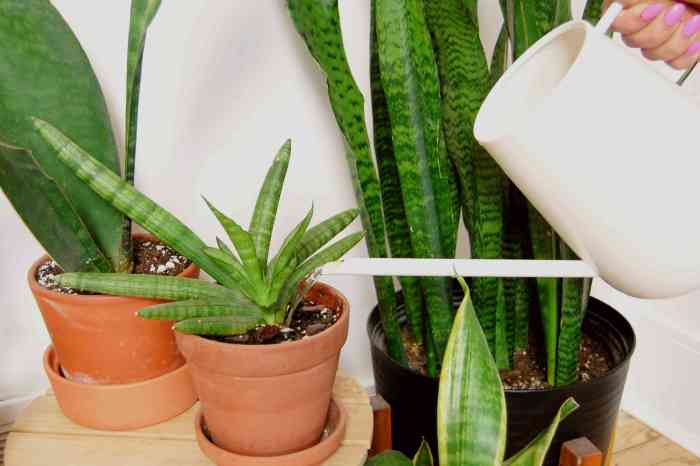When to Water Snake Plant
Understanding Snake Plant Watering Needs
When to water snake plant – Proper watering is crucial for the health and longevity of your snake plant. Understanding the factors that influence watering frequency will help you avoid common pitfalls like underwatering and overwatering. This section details these factors and the visual cues that indicate your plant’s hydration status.
Factors Influencing Watering Frequency
Several factors interact to determine how often you need to water your snake plant. These include pot size, soil type, season, humidity levels, and light exposure. Larger pots retain moisture longer than smaller ones, while well-draining soil dries out faster than dense soil. Similarly, snake plants in humid environments require less frequent watering than those in dry climates. Plants in bright, direct sunlight will dry out more quickly than those in low-light conditions.
Signs of Underwatered and Overwatered Snake Plants
Recognizing the signs of both underwatering and overwatering is key to maintaining a healthy snake plant. Underwatering manifests as dry, brittle leaves that may curl or droop. The soil will be completely dry to the touch. Overwatering, on the other hand, leads to soft, mushy leaves, yellowing, and potential root rot. The soil will remain consistently damp or soggy.
Watering Needs in Different Environments
| Environment | Watering Frequency (Summer) | Watering Frequency (Winter) | Notes |
|---|---|---|---|
| Low Light, Dry | Every 2-3 weeks | Every 4-6 weeks | Allow soil to dry completely between waterings. |
| High Light, Dry | Every 1-2 weeks | Every 3-4 weeks | Monitor soil moisture closely; may need more frequent watering. |
| Low Light, Humid | Every 3-4 weeks | Every 6-8 weeks | Water less frequently due to higher humidity. |
| High Light, Humid | Every 2-3 weeks | Every 4-5 weeks | Balance light exposure and humidity when determining watering schedule. |
Developing a Watering Schedule

Source: thespruce.com
Creating a consistent watering schedule is essential for preventing both underwatering and overwatering. This section Artikels a sample schedule and offers tips for adapting it to your specific environment and plant’s growth stage.
Sample Watering Schedule
This is a general guideline; adjust based on your specific environment and plant’s needs. Always check the soil moisture before watering.
| Season | Watering Frequency |
|---|---|
| Spring | Every 1-2 weeks |
| Summer | Every 1-2 weeks (potentially more frequently in hot, dry climates) |
| Autumn | Every 2-3 weeks |
| Winter | Every 4-6 weeks (or even less frequently) |
Adjusting Watering Frequency
Several factors necessitate adjustments to your watering schedule. Increased light exposure, higher temperatures, and active growth periods (spring and summer) will require more frequent watering. Conversely, decreased light, cooler temperatures, and dormancy (winter) warrant less frequent watering. Always prioritize the “finger test” to ensure you are not overwatering.
Importance of the Finger Test
The “finger test” is a simple yet effective method for determining soil moisture. Insert your finger about an inch into the soil. If the soil feels dry, it’s time to water. If it’s still moist, wait a few more days before watering.
Watering Techniques and Methods
Several methods exist for watering snake plants, each with its own advantages and disadvantages. This section explores top watering, bottom watering, and soaking, highlighting best practices to prevent root rot and other issues.
Watering Methods

Source: shuncy.com
Choosing the right watering method can significantly impact your snake plant’s health. Here’s a comparison of three common methods:
- Top Watering: Pour water slowly and gently onto the soil surface, allowing it to soak in. Avoid getting water on the leaves or crown to prevent rot.
- Bottom Watering: Place the pot in a tray of water for about 30 minutes, allowing the soil to absorb moisture from the bottom. This method is gentler and helps prevent overwatering.
- Soaking: Completely submerge the pot in a container of water for a few hours, allowing the soil to become thoroughly saturated. This is best for very dry soil but should be used sparingly to avoid overwatering.
Best Practices for Watering Snake Plants
- Use lukewarm water to avoid shocking the roots.
- Allow excess water to drain completely from the pot to prevent root rot.
- Avoid overwatering, which is a more common problem than underwatering for snake plants.
- Use well-draining potting mix.
- Inspect your plant regularly for signs of underwatering or overwatering.
Addressing Common Watering Problems
Improper watering can lead to several issues, including yellowing leaves, leaf drop, and root rot. This section details how to identify and address these problems, including steps for repotting a snake plant with root rot.
Common Watering Problems and Solutions
Yellowing leaves, leaf drop, and root rot are common signs of watering issues. Yellowing leaves often indicate overwatering, while leaf drop can be caused by both overwatering and underwatering. Root rot, a serious condition, is almost always a result of overwatering.
Reviving an Underwatered or Overwatered Snake Plant
For underwatered plants, gradually reintroduce water, using the finger test to guide you. For overwatered plants, allow the soil to dry completely before watering again. You may need to repot the plant if root rot is present.
Repotting a Snake Plant with Root Rot, When to water snake plant
- Carefully remove the plant from its pot.
- Gently rinse the roots to remove excess soil.
- Trim away any mushy or brown, rotten roots using sterilized pruning shears.
- Allow the roots to air dry for a few hours.
- Repot the plant in fresh, well-draining potting mix.
- Water sparingly until new growth appears.
Visual Aids: Illustrating Watering Techniques: When To Water Snake Plant
Illustration: Correct Top-Watering Technique
The illustration shows water being poured slowly and gently onto the soil surface, ensuring the water flows evenly around the base of the plant. Crucially, the water stream is directed to the outer edges of the pot, avoiding the crown of the plant where water accumulation can lead to rot. The image highlights the importance of using a watering can with a narrow spout for precise control.
The soil is shown absorbing the water gradually, indicating proper watering.
Illustration: Signs of Overwatering and Underwatering
The illustration contrasts a healthy snake plant with plants exhibiting signs of overwatering and underwatering. The healthy plant displays firm, upright leaves of a vibrant green color. The underwatered plant shows shriveled, curled leaves with a dull, pale green color. The soil is noticeably dry and cracked. The overwatered plant has soft, yellowing, and possibly drooping leaves.
The soil appears soggy and dark, and the roots might be visibly decaying (brown and mushy). The illustration clearly distinguishes the visual cues for each condition, emphasizing the importance of careful observation.
Quick FAQs
How often should I check the soil moisture?
Check the soil moisture at least once a week, or more frequently during warmer months.
What type of water is best for snake plants?
Use lukewarm, filtered water to avoid chlorine and other chemicals that can harm the plant.
My snake plant’s leaves are drooping. Is it overwatered or underwatered?
Drooping leaves can indicate both overwatering (soft, mushy leaves) or underwatering (crisp, dry leaves). Check the soil moisture to determine the cause.
Can I use tap water?
While tap water can be used, letting it sit out overnight to allow chlorine to dissipate is recommended.
What should I do if my snake plant develops root rot?
Remove the affected roots, repot the plant in fresh, well-draining soil, and adjust your watering schedule.




















